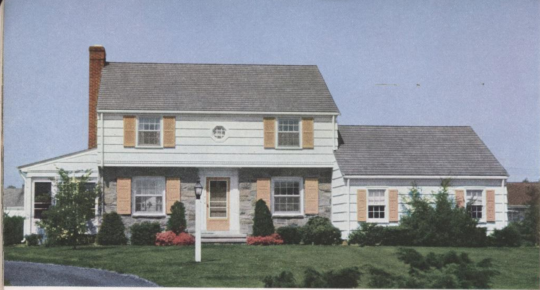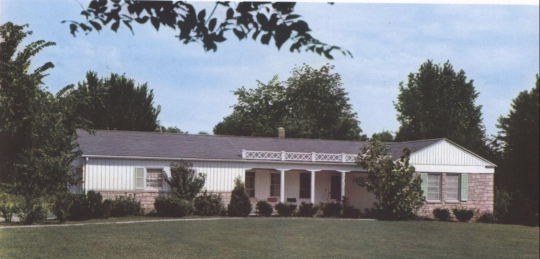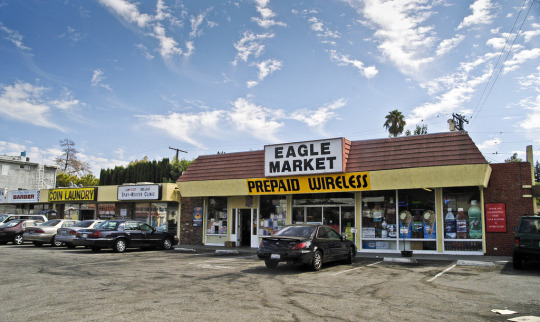All Buildings Are Interesting
McMansion Hell
Consider this statement: All buildings are interesting. There is not a single building that isn’t interesting in some way.
To say that something is interesting is not a qualitative statement - it does not imply that all buildings are “good” or “bad,” or that all buildings are Important Architecture® - only that they are interesting.

When I tweeted this idea, several folks responded in the comments with buildings they thought were Not Interesting, yet somehow interesting enough to warrant a web search, image download, and a response to the tweet. Most of these buildings were part of our everyday mundane American landscape: a university building, a ranch house, an Applebee’s. However, as the discussion unfurled, it quickly became evident that even the most quotidian buildings are, in fact, interesting.
Botanists bemoan what is called “Tree Blindness”: a phenomenon where, for most people, trees are only a green background for literally whatever else is going on. Tree Blindness keeps people from understanding the world they live in on another level, from having a personal connection to the environment. Knowing the names of the trees on my street makes each of them special and memorable. If one of them were to be lost - like the hemlock, which is being tragically eviscerated by the wooly hemlock adelgid - it would be like losing a friend, something that was a part of my world rather than an another alarming headline, lost in an endless sea of other alarming headlines.
I would say that we also suffer from building blindness, which is ostensibly not as serious as Tree Blindness, as the consequences of building blindness are much less dire. Still, being blind to buildings robs us of a deeper level of understanding and interaction with the world around us.
Unlike plants, buildings aren’t meticulously taxonomized.
Common systems of analysis such as schools of architectural thought or architectural styles are merely one way of categorizing architecture (and a flawed one, as seen by the wide misuse of the term Brutalism as a synonym for “any concrete building ever”). Unfortunately, these designations are often not applicable to the buildings we see every day.

Those who study “vernacular architecture” (once meaning “folk” or “self-built” architecture, but now referring to common architecture, the architecture of everyday), have developed other systems of analysis such as reading floor plans, which are more useful for studying most American residential architecture, yet even these methods are not standard across the field.
However, even buildings that don’t fit into any academically established system of analysis can still be analyzed, and are still interesting. Most of us, regardless of our experience in architecture, have built up an encyclopedia of buildings in our heads - whether by architectural program (e.g. hospitals, shopping centers, single family homes), geographical place (neighborhood, town, city, suburb), or some kind of distinguishing feature (shared architectural elements, color, size, age).
Looking at “boring” buildings

At least one person who commented on my “all buildings are interesting” tweet cited the ranch house as an example of a not interesting building.
These two are both ranch houses, but are very different from each other! When asked why they are different, you might say that the first is larger and fancier than the second, or that they use different materials, or that the first has a porch or and the other a front-facing garage.
Yet still, we see these two houses, which look quite different, and can say they are both ranches. Why? Where did we learn that word “ranch”? Was it from our parents, or from a song, or maybe HGTV? What tells us that these houses are ranches?
Well, you might say that a ranch is a house that has certain characteristics: it’s more horizontal than vertical; it is “long,” simple in its design, and usually has certain features like a picture window, or an attached garage. You might cite a certain time period (e.g. the 1950s) or a certain geography (the suburbs), or a use (as a family home).
Why do we know that these houses are ranches? There are certain signs that tell us that this is a ranch, and not a Cape Cod, nor a McMansion. Still also, without knowing how expensive either house is, there are certain signs that tell us that the first house is “fancier” than the second house (e.g. the architectural detailing above the porch, the porch itself, the concealed garage). Above all, what does the ranch house itself mean (or signify) to us? An American Family Home™? (There’s a lot to unpack in that idea alone.) A potential fixer upper? The suffocating isolation of suburbia? American conformity? A bygone era where boys were men etc etc.? Cisheteropatriarchy?
We can ask many questions: Do we like the ranch house? Is it a “good” house compared to other house types? Will we ever build ranch houses like these again? Why do ranch houses exist in the first place? What kind of people do we think lived in either of the two houses, and what do those houses say about them? Is the ranch politicized in any way? What are the politics of the ranch? The economics? The history?
We’ve taken a few minutes to dwell on our two “boring” houses – individually, compared to each other, and to our ideal perfect image of what a ranch house is – and have found that they are very interesting. In fact, there are many fascinating aspects of the ranch the literature hasn’t examined because the ranch house is “a boring” building.
Our own personal architectural encyclopedias
Most of us will say to ourselves, “I’m not an expert on architecture.” Sure, you might not have built a skyscraper or have read Many Important Architecture Books, but the truth is a lot of us have built up a ton of knowledge about buildings that we see or use every day.

One of the questions I get asked all the time is “What is a McMansion?” I’ve started to trust in others and simply say, “A McMansion is like obscenity: you know it when you see it.” Which is true! If McMansions weren’t an architectural (and cultural) phenomenon, nobody would read this blog. You all know what a McMansion is. You all know what a Ranch is. Most of you know what a strip mall looks like.
We’ve built up all kinds of personal databases of buildings. Some of them are pretty general: split level houses, gas stations, water towers, etc. Some are more specific: fast food chains (new), fast food chains tA ranch house c. 1955. Public Domain (via Archive.org)hat haven’t been remodeled yet, “new” apartment buildings, dilapidated hotels by the sides of highways, office parks, churches that used to be something else, etc. (I personally have a category called hospitals built in the early 00s that were doing Postmodern Prairie chic.)
We often don’t think about why brands (especially fast food chains) brand their architecture as well as their logos. All of us can vaguely picture a McDonalds, any McDonalds. Brands have created their own architectural icons for the sole purpose of sticking around in your personal architectural encyclopedia.
Like I said earlier, a lot of the time we don’t have a common language to describe these buildings. Some people come up with pejorative names to describe built phenomenon (the McMansion is the prime example of this). Others try to define buildings by decade (e.g. 70s malls vs 80s malls).
However, this lack of common language hasn’t stopped hundreds of makeshift historians from relentlessly categorizing buildings, styles, aesthetics, and anything else that can be filmed, photographed, or written about online. And frankly, this work is fascinating, it is important, it is exciting, and it needs to be done.
Throughout my short life, I’ve been fascinated with the mundane, because, like most of us in the USA, the word mundane describes many of the landscapes we encounter every day. This long fascination has brought me into contact with all kinds of interesting subjects both offline (historic preservationists, books about common houses and office parks, architectural theory) and online (Flickr groups with 20-something thousand photos devoted to Kmart; filmmakers like Dan Bell, who meticulously documents dead malls; a website memorializing Howard Johnson’s Restaurants, and Tumblrs like @y2kaestheticinstitute).
There are tons of people who are, of their own accord, trying to piece together ethnographies of these landscapes because in the world of the everyday, buildings change quickly and frequently, which makes them interesting, by the way. (How many of the once-ubiquitous McDonald’s restaurants with the red roofs are left, do you think? Some person Online for sure knows the answer.)
On Flickr alone (where I’ve been a lurker for about a decade), there are robust groups such as Vintage Discount Stores, Retail Recycle, Arrow Signs, sub/urbanscape and Concrete Block Walls. Individual photographers have devoted themselves to taking thousands of pictures of buildings most of us wouldn’t think twice about. One such photographer, Charles Hathaway, a self-reported cook at Mazzio’s Pizza, has uploaded over 10,000 photos of restaurants, hotels, shopping centers, and more, meticulously documenting their changes, what used to occupy them, and their architecture, down to the detail.
Nostalgia plays a major part in why a lot of people participate in “Old Buildings from [Place]” Facebook groups, and yes, the fact that there are strings of excited internet comments reliving childhood memories of shopping at Kmart speaks quite a bit about American culture (and its relationship to architecture, which is interesting.)
However, we shouldn’t be too quick to be derisive, because this feeling of excitement is pretty much universal. If there is a place – whether it’s iconic “capital A” Architecture (say, Fallingwater), or as mundane as a Kmart – that has been lost to us in some way, to see photos of it triggers our memory; we think about events or people we haven’t thought about in years. Often, a strange feeling of grief washes over us – not over the building specifically – but as a part of a greater realization: that time passes, the world changes, and that buildings (which we subconsciously consider to be permanent, physical markers of an era) are actually quite ephemeral.